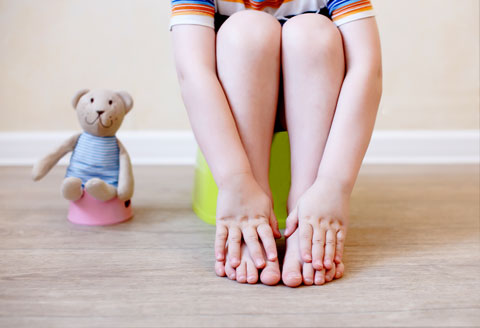Learning to use the toilet is a big step for a child. When your child seems ready, start slowly, and be patient.
Get the right equipment.
Decide on a stand-alone potty chair or a toddler seat that fits on your regular toilet. To use a regular toilet, your child will probably need a stepstool. (A child needs to be able to reach the seat and to be able to have feet on a surface for leverage.)
Help your child identify the right place and time.
Place the potty chair where she can easily reach it, and explain what you want. When she urinates or has a bowel movement in her diaper, clean it up calmly and let her know that she can do that in the potty now. You may want to put the bowel movement from her diaper into the potty and comment on this being the place for it. If the sound of the flush seems to frighten her, wait until she is out of the bathroom. Encourage her to sit on the potty chair when she may need to use it. (For many children, this is after sleeping or eating.)
Teach additional skills gradually.
Once he is using the toilet some of the time, teach him to wipe, flush, take care of his clothing, and wash his hands. Many children need help with wiping after a bowel movement until they are 4 years old or older. Now may be a time to try training pants or “big kid” underwear. Many children are not ready to give up diapers at night for several months after learning to use the toilet during the day. When he can stay dry for several hours during the day, try sending him to bed without diapers.
Work with your child care provider.
Your child care provider can help in encouraging toilet use. Try to use the same words and routines for toilet use that your provider uses. At first, your child may go at home but not at child care, or just the opposite. If she only wants to go with your help, gradually encourage her to be more independent.
Be prepared for setbacks.
Illness or a stressful change in his life may cause your child to regress. And it’s not unusual for some children to become so engrossed in their play or in learning something new that they forget or don’t want to take the time to use the toilet. Try gentle reminders or regular breaks. Let his doctor know if your child becomes constipated or has painful bowel movements or other problems.
Praise your child for any successes.
If she tells you after soiling or wetting a diaper, that’s progress. If she urinates on the way to the toilet, that’s also progress. Remember that she’s trying, so it’s important to treat accidents matter-of-factly and keep encouraging her. If she becomes discouraged, consider waiting a few weeks or months and then trying again. Avoid letting toilet training become a power struggle—or a major source of stress for you both.


 PDF
PDF